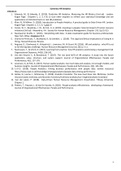Summary
Summary HR Analytics
- Course
- Institution
Summary of the following literature: 1. Edwards, M., & Edwards, K. (2019). Predictive HR Analytics: Mastering the HR Metrics (2nd ed). London: Kogan Page. Chapters 1, 2, 3, 4 & 12 (use other chapters to refresh your statistical knowledge and see applications of statistical tools on real HR prob...
[Show more]



